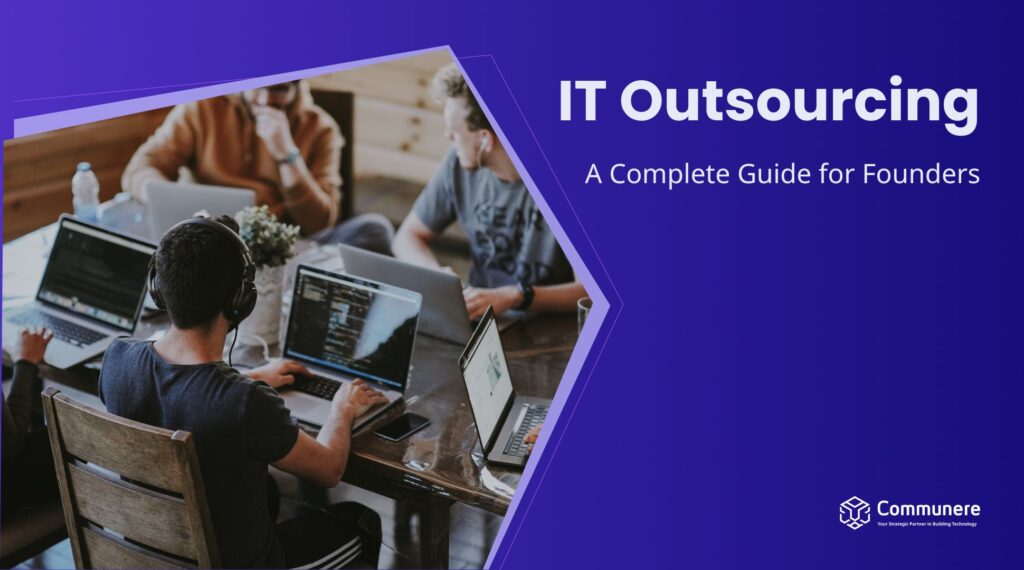Technology firms and startups constantly seek innovative strategies to stay competitive and agile. IT Staff Augmentation emerges as a pivotal solution in this context, addressing the demands of the industry by empowering businesses to scale their workforce flexibly and efficiently. This model is not a trend but a strategic approach to talent management that aligns with the modern-day imperative for speed, adaptability, and specialisation.
Table of Contents
- What is IT Staff Augmentation?
- The Rise of IT Staff Augmentation as a Service
- Talent Shortage in the Tech Industry
- Market Trends and Demand for Tech Talent
- Industry-Wide Adoption Across Various Sectors
- The Strategic Advantage of Flexibility and Specialisation
- Top 5 Benefits of IT Staff Augmentation
- Improved Resource Management and Cost Savings
- Access to Specialised Skills
- Flexibility and Scalability
- Reduced Administrative Burden
- Enhanced Project Control and Team Integration
- IT Staff Augmentation Challenges and Solutions
- IT Staff Augmentation vs. Other Outsourcing Models
- Implementing IT Staff Augmentation Successfully
- Conclusion
What is IT Staff Augmentation?
IT Staff Augmentation is a form of outsourcing strategy in which businesses augment their in-house team with external IT professionals on a temporary basis. This method allows companies to address specific project needs and skill gaps or scale their teams up or down according to project demands without the long-term commitments associated with hiring full-time developers. The essence of IT Staff Augmentation lies in its ability to provide businesses with direct access to a global pool of specialised talent, offering a strategic blend of internal and external resources to meet project objectives efficiently.
The significance of IT Staff Augmentation in today’s business environment cannot be overstated. With the tech industry facing a significant talent shortage, particularly in specialised areas, companies are under increasing pressure to find innovative ways to secure the necessary expertise to drive their projects forward. IT Staff Augmentation addresses this challenge head-on, offering a flexible solution that not only fills immediate talent gaps but also provides a competitive edge in a market where agility and specialised skills are paramount.
Moreover, the model’s growing popularity across industries highlights its versatility and effectiveness in responding to the changing needs of the enterprise. From software development to cloud computing, data analysis to cybersecurity, IT Staff Augmentation enables businesses to leverage specific skills on-demand, thereby enhancing their capability to innovate and execute projects with precision and speed.
The Rise of IT Staff Augmentation as a Service
The ascent of IT Staff Augmentation as a favoured strategic approach for talent acquisition and management is a reflection of the broader shifts within the global business and technology landscapes. This surge can be traced back to several key factors that collectively underscore this model’s growing appeal and applicability in meeting contemporary workforce demands.
Talent Shortage in the Tech Industry
A critical driver behind the rise of IT Staff Augmentation is the pronounced talent shortage within the technology sector. An analysis covering the period from 2016 to 2019 highlighted a significant disparity in the ability of employers in the United States to fill tech positions compared to non-tech roles. This shortage is not just a temporary challenge but a persistent issue, with projections suggesting a continuing and potentially increasing gap between the demand for tech talent and the supply available through traditional hiring channels.
Market Trends and Demand for Tech Talent
The demand for tech talent has been on a steady incline, with expectations for this trend to persist into the next decade. The tech employment landscape is poised for expansion, necessitating an infusion of new talent to fill new positions and replace those exiting the sector due to retirement or other factors. Given the current output of graduates with relevant degrees, this scenario presents a formidable challenge, underscoring the necessity for alternative solutions like IT Staff Augmentation to bridge the gap.
Industry-Wide Adoption Across Various Sectors
The utilisation of IT Staff Augmentation transcends industry boundaries, gaining traction across a wide array of sectors, including manufacturing, transportation, logistics, and beyond. This widespread adoption indicates the model’s versatility and capacity to address the unique challenges faced by different industries in integrating technology into their operations. Companies are increasingly relying on IT Staff Augmentation to access specialised skills and drive technological innovation, from cloud computing and data management to the development of logistics software and transportation solutions.
The Strategic Advantage of Flexibility and Specialisation
Businesses today operate in an environment characterised by rapid technological advancements and fluctuating market demands. IT Staff Augmentation offers a strategic advantage by providing the flexibility to scale teams up or down based on project requirements and the ability to access specialised skills on demand. This agility enables companies to respond swiftly to new opportunities, manage project costs effectively, and maintain a competitive edge in a fast-paced market.
In essence, IT Staff Augmentation is a direct response to the dynamics of the global workforce management and the specific challenges within the tech industry. By offering a flexible and efficient solution to the talent shortage, enabling access to a global pool of specialised skills, and providing the agility needed to navigate the complexities of the modern business landscape, IT Staff Augmentation has established itself as an indispensable strategy for forward-thinking companies aiming to thrive in the digital era.
Top 5 Benefits of IT Staff Augmentation
IT Staff Augmentation offers a myriad of advantages for businesses navigating the complexities of today’s technological landscape. These benefits stem from the model’s inherent flexibility, efficiency, and ability to provide specialised skills on demand. Below, we delve into the key benefits that make IT Staff Augmentation a strategic choice for organisations looking to bolster their IT capabilities.
Improved Resource Management and Cost Savings
One of the most significant advantages of IT Staff Augmentation is the enhanced ability to manage resources effectively. By adopting this model, businesses can align their workforce precisely with project requirements, ensuring that the right skills are available at the right time. This strategic alignment not only boosts project efficiency but also results in considerable cost savings. Businesses can avoid the expenses associated with full-time hiring, such as benefits, taxes, and long-term salary commitments, and minimise the need for extensive training and development.
Access to Specialised Skills
IT Staff Augmentation enables businesses to tap into a vast and global talent pool, bringing in niche or high-demand skills for specific projects or initiatives. This approach ensures that organisations can secure the necessary expertise without the long-term investment in skill development, providing a competitive edge in project execution and innovation.
Flexibility and Scalability
The dynamic nature of the business landscape requires organisations to be agile and capable of adapting quickly to new challenges and opportunities. IT Staff Augmentation offers unmatched flexibility and scalability in workforce management, allowing companies to adjust their staff levels in response to project demands, market changes, or business needs. This agility is crucial for maintaining operational efficiency and capitalising on opportunities as they arise.
Reduced Administrative Burden
Staff Augmentation simplifies the administrative workload associated with recruitment, payroll, and contract management. By outsourcing these tasks to the staffing provider, businesses can focus more on core operations and strategic initiatives. This reduction in administrative duties not only saves time but also allows for a more efficient allocation of resources towards achieving business goals.
Enhanced Project Control and Team Integration
Unlike some outsourcing models that can dilute project control, IT Staff Augmentation allows businesses to retain significant oversight and direction over the augmented staff. This model ensures that external professionals work under the company’s management and alongside existing employees, fostering better integration and collaboration within teams. Effective integration is critical for maintaining project alignment and achieving desired outcomes, with the augmented staff contributing to the collective effort as if they were in-house team members
IT Staff Augmentation Challenges and Solutions
While IT Staff Augmentation offers a host of benefits, including flexibility, access to a global talent pool, and cost savings, it also comes with its own set of challenges. These challenges can impact communication, integration, and the overall effectiveness of augmented teams if not properly addressed. Below are some of the common challenges faced in IT Staff Augmentation and strategies to overcome them.
Challenges
Managing Communication Across Teams
Effective communication is crucial in any project but becomes more complex in a setup involving augmented staff. Differences in time zones, language barriers, and cultural differences can hinder smooth communication and collaboration among team members.
Integration of Augmented Staff into Existing Teams
Integrating augmented staff into existing teams and company culture can be challenging. There’s often a need to quickly onboard external professionals and ensure they work cohesively with in-house employees, which can be difficult without proper planning.
Ensuring Consistency in Work Quality
Maintaining a consistent level of work quality across a team that includes both in-house and augmented staff can be a concern, especially when external team members are not as familiar with the company’s standards and processes.
Solutions
Enhancing Communication Strategies
To address communication challenges, companies can leverage modern communication tools and establish clear communication protocols. Regularly scheduled meetings, the use of collaborative platforms (like Slack, Microsoft Teams), and clear documentation can help ensure that all team members, regardless of location, are on the same page.
Structured Onboarding and Integration Processes
Creating a structured onboarding process for augmented staff can facilitate smoother integration into existing teams. This might include comprehensive introductions to the company’s culture, goals, and work processes. Inclusion in relevant meetings and team-building activities can also promote a sense of belonging and teamwork.
Maintaining Quality Control
To ensure consistency in work quality, clear guidelines and standards should be communicated from the start. Regular check-ins and reviews can help monitor progress and maintain quality. Providing feedback and conducting training sessions when necessary can also help align augmented staff with the company’s quality expectations.
IT Staff Augmentation vs. Other Outsourcing Models
Companies often explore various outsourcing models to address their needs for expertise, scalability, and cost efficiency. IT Staff Augmentation, Managed Services, and Independent Contractors are three prominent models, each with its unique advantages and considerations. Understanding the differences between these models can help businesses choose the most suitable approach for their specific needs.
IT Staff Augmentation vs. Managed Services
IT Staff Augmentation allows companies to temporarily extend their in-house teams with external IT professionals. This model is highly flexible, offering businesses the ability to scale their workforce up or down based on project demands and access specialised skills on a short-term basis. The primary advantage is the enhanced control it gives companies over their projects and the integration of external talent into their existing teams.
Managed Services, on the other hand, involve outsourcing entire IT functions or projects to a third-party provider who assumes full responsibility for the operations and delivery of services. This model is more comprehensive and is suited for businesses looking for a hands-off approach to managing specific IT functions without the day-to-day oversight required in staff augmentation. Managed services can offer cost predictability and ease of management but might result in less control over specific project outcomes and processes.
IT Staff Augmentation vs. Independent Contractors
Independent Contractors are self-employed individuals hired on a project basis, providing services under a contractual agreement. While there’s some overlap with IT Staff Augmentation in terms of flexibility and access to a wide talent pool, hiring independent contractors is generally more suited for smaller, well-defined projects or when a company needs a highly specialised skill for a short period. Unlike staff augmentation, where the staffing company often handles administrative aspects like payroll and compliance, working with independent contractors requires managing these elements directly, which can be both a flexibility advantage and an administrative burden.
Key Considerations:
- Control and Integration: Staff Augmentation offers greater control over projects and easier integration of talent into existing teams compared to Managed Services, which operate more independently.
- Scope and Responsibility: Managed Services provide a comprehensive solution where the vendor takes complete responsibility for specific IT functions, offering a hands-off approach for companies. In contrast, Staff Augmentation and working with Independent Contractors require the company to maintain more direct oversight and management of the external resources.
- Flexibility and Cost: While Staff Augmentation and hiring Independent Contractors offer more flexibility to scale teams and manage costs based on short-term needs, Managed Services might provide more predictable pricing and reduced management overhead for long-term engagements.
Implementing IT Staff Augmentation Successfully
Successfully implementing IT Staff Augmentation is a strategic process that requires careful planning, clear communication, and effective management. By following a set of best practices, organisations can maximise the benefits of this flexible staffing model while mitigating potential challenges.
Identify the Skills You Need
The first step in a successful IT Staff Augmentation strategy is to conduct a thorough assessment of your current team’s capabilities and identify the specific skills gaps or project needs. Understanding the precise nature of the expertise required enables you to articulate clear objectives and expectations to your staffing partner.
Choose the Right Staff Augmentation Partner
It is crucial to select a staffing partner who aligns with your business objectives and cultural values. Look for providers with a proven track record, positive client testimonials, and the ability to supply talent that matches your technical and soft skill requirements. The right partner should act as an extension of your team, demonstrating an understanding of your industry and the unique challenges your projects face.
Ensure Clear Communication
Effective communication is the backbone of any successful project, more so in an augmented staff model where team members may be distributed across different locations. Establishing clear lines of communication, setting expectations early, and utilising collaborative tools can help maintain project alignment and foster a cohesive working environment.
Implement a Structured Onboarding Process
A well-structured onboarding process ensures that augmented staff are integrated into your team effectively, understanding your company’s processes, tools, and culture from the start. This includes technical orientation and aligning on project goals, methodologies, and expectations. The quicker the augmented staff feels part of the team, the more efficiently they can contribute to your project’s success.
Maintain Regular Oversight and Feedback
Continuous oversight and regular feedback loops are essential for managing augmented teams effectively. This approach helps promptly address any issues, adjust project directions as necessary, and ensure the quality of work meets your standards. Regular check-ins and performance reviews can also motivate augmented staff and help them align more closely with project objectives.
Foster a Collaborative Culture
Creating a culture that values inclusivity and collaboration is key to successfully integrating augmented staff. Encourage interaction among team members, recognise contributions, and create opportunities for knowledge sharing. A collaborative culture enhances project outcomes and improves team satisfaction and retention.
Leverage Technology for Efficiency
Utilise project management and communication tools to streamline workflows, enhance collaboration, and maintain transparency across the team. Tools like JIRA for project management, Slack for communication, and GitHub for code sharing can facilitate seamless collaboration among in-house and augmented staff.
Implementing IT Staff Augmentation successfully requires a balanced approach that combines strategic planning with effective communication and management practices. By carefully selecting the right talent, fostering a collaborative culture, and maintaining clear communication and oversight, organisations can leverage the full potential of IT Staff Augmentation to achieve their project goals and drive business growth.
Conclusion
IT Staff Augmentation is a strategic solution offering flexibility, access to specialised skills, and a competitive edge. While this model presents its own set of challenges, it provides a robust framework for companies to scale their workforce, manage resource allocation efficiently, and enhance project execution through access to a global talent pool.
The key to leveraging IT Staff Augmentation effectively lies in identifying precise skill requirements, selecting the right staffing partner, ensuring clear and effective communication, and fostering a culture of collaboration and inclusion. By implementing structured onboarding processes and maintaining regular oversight, companies can integrate augmented staff seamlessly into their existing teams, ensuring high-quality project outcomes and maintaining project alignment.
Moreover, IT Staff Augmentation offers a strategic advantage over traditional hiring and other outsourcing models by providing a flexible and cost-effective solution to the pressing talent shortages faced across industries. It allows businesses to adapt quickly to changing market demands, access specialised expertise on demand, and maintain operational agility without the long-term commitments associated with full-time hires.
In conclusion, IT Staff Augmentation is more than just a temporary solution to talent gaps; it’s a strategic approach to building a dynamic, skilled, and responsive workforce. As the demand for technological expertise continues to grow, so too will the importance of IT Staff Augmentation as a key component of a workforce strategy for businesses looking to thrive in an increasingly digital world. By embracing this model, companies can address their immediate project needs and position themselves for long-term success in the ever-evolving landscape of technology and business.
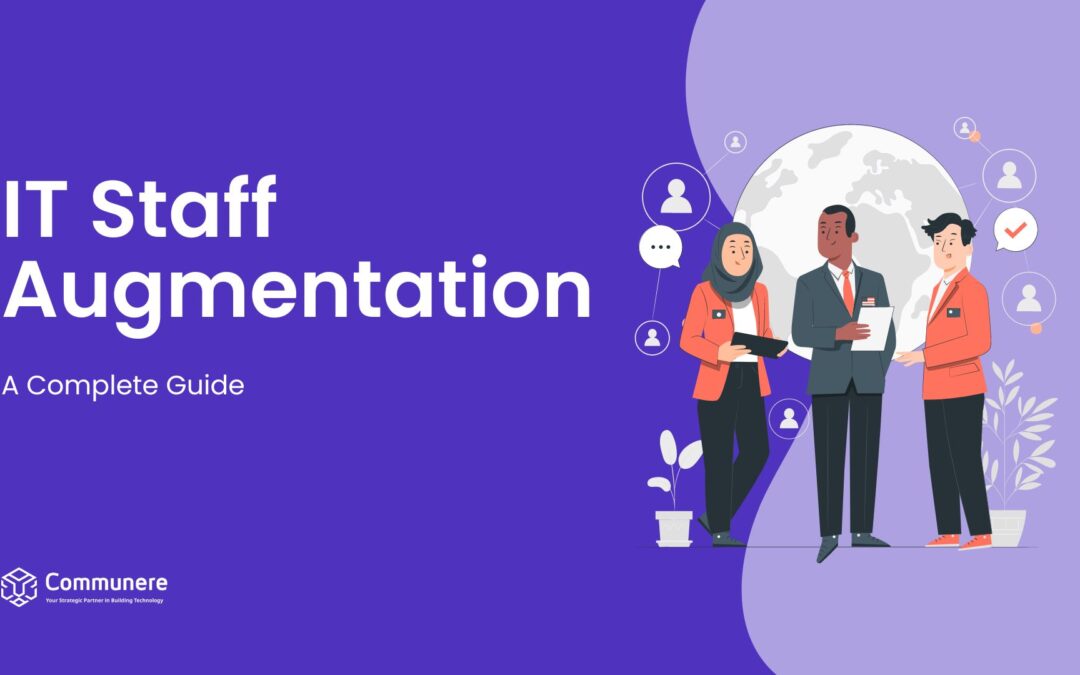
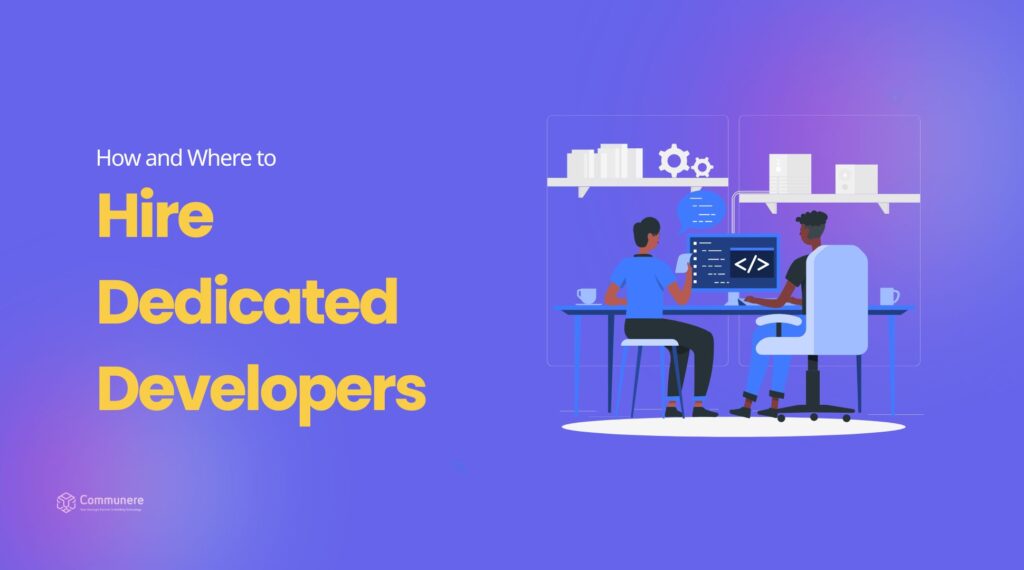
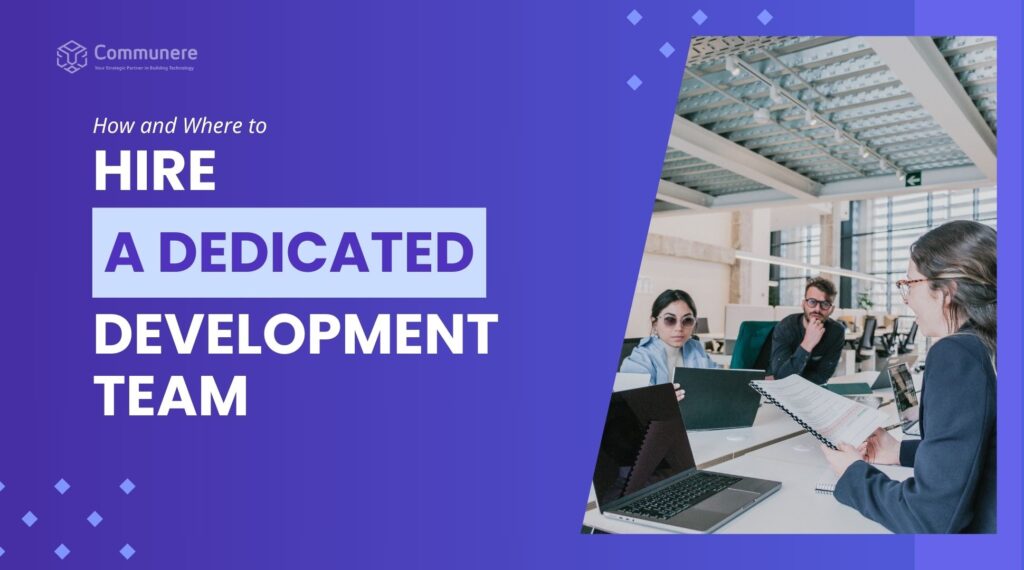
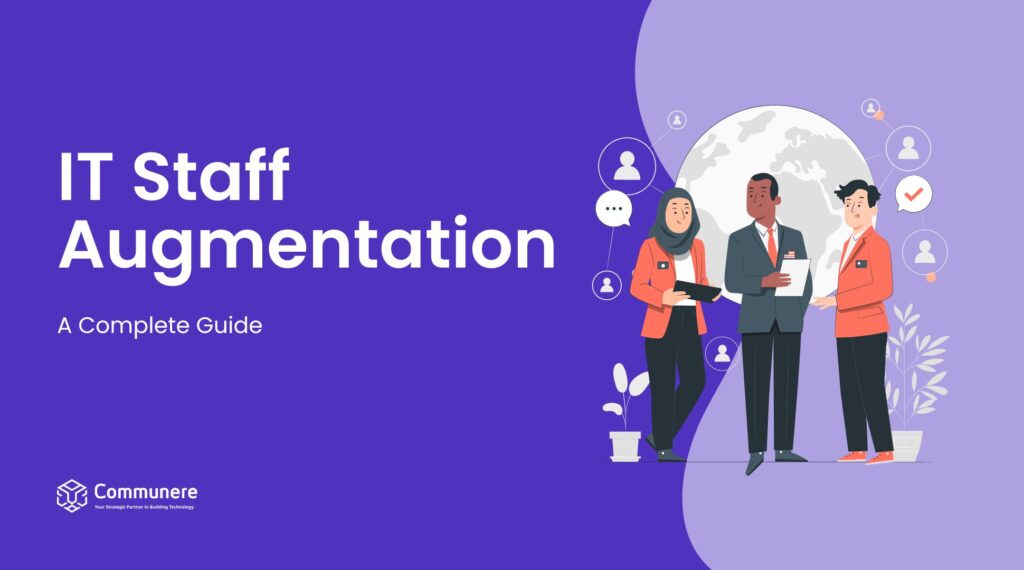
![Why Custom Web Development is the Best Approach [2024]](https://resources.communere.com/wp-content/uploads/2024/02/Why-Custom-Web-Development-is-the-Best-Approach-1024x570.jpg)

